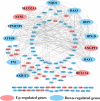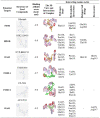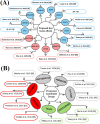Integrated bioinformatics and statistical approaches to explore molecular biomarkers for breast cancer diagnosis, prognosis and therapies
- PMID: 35617355
- PMCID: PMC9135200
- DOI: 10.1371/journal.pone.0268967
Integrated bioinformatics and statistical approaches to explore molecular biomarkers for breast cancer diagnosis, prognosis and therapies
Abstract
Integrated bioinformatics and statistical approaches are now playing the vital role in identifying potential molecular biomarkers more accurately in presence of huge number of alternatives for disease diagnosis, prognosis and therapies by reducing time and cost compared to the wet-lab based experimental procedures. Breast cancer (BC) is one of the leading causes of cancer related deaths for women worldwide. Several dry-lab and wet-lab based studies have identified different sets of molecular biomarkers for BC. But they did not compare their results to each other so much either computationally or experimentally. In this study, an attempt was made to propose a set of molecular biomarkers that might be more effective for BC diagnosis, prognosis and therapies, by using the integrated bioinformatics and statistical approaches. At first, we identified 190 differentially expressed genes (DEGs) between BC and control samples by using the statistical LIMMA approach. Then we identified 13 DEGs (AKR1C1, IRF9, OAS1, OAS3, SLCO2A1, NT5E, NQO1, ANGPT1, FN1, ATF6B, HPGD, BCL11A, and TP53INP1) as the key genes (KGs) by protein-protein interaction (PPI) network analysis. Then we investigated the pathogenetic processes of DEGs highlighting KGs by GO terms and KEGG pathway enrichment analysis. Moreover, we disclosed the transcriptional and post-transcriptional regulatory factors of KGs by their interaction network analysis with the transcription factors (TFs) and micro-RNAs. Both supervised and unsupervised learning's including multivariate survival analysis results confirmed the strong prognostic power of the proposed KGs. Finally, we suggested KGs-guided computationally more effective seven candidate drugs (NVP-BHG712, Nilotinib, GSK2126458, YM201636, TG-02, CX-5461, AP-24534) compared to other published drugs by cross-validation with the state-of-the-art alternatives top-ranked independent receptor proteins. Thus, our findings might be played a vital role in breast cancer diagnosis, prognosis and therapies.
Conflict of interest statement
The authors have declared that no competing interests exist.
Figures








Similar articles
-
Bioinformatics Screening of Potential Biomarkers from mRNA Expression Profiles to Discover Drug Targets and Agents for Cervical Cancer.Int J Mol Sci. 2022 Apr 2;23(7):3968. doi: 10.3390/ijms23073968. Int J Mol Sci. 2022. PMID: 35409328 Free PMC article.
-
Statistics and network-based approaches to identify molecular mechanisms that drive the progression of breast cancer.Comput Biol Med. 2022 Jun;145:105508. doi: 10.1016/j.compbiomed.2022.105508. Epub 2022 Apr 14. Comput Biol Med. 2022. PMID: 35447458
-
Robust Identification of Differential Gene Expression Patterns from Multiple Transcriptomics Datasets for Early Diagnosis, Prognosis, and Therapies for Breast Cancer.Medicina (Kaunas). 2023 Sep 24;59(10):1705. doi: 10.3390/medicina59101705. Medicina (Kaunas). 2023. PMID: 37893423 Free PMC article.
-
Robust identification of common genomic biomarkers from multiple gene expression profiles for the prognosis, diagnosis, and therapies of pancreatic cancer.Comput Biol Med. 2023 Jan;152:106411. doi: 10.1016/j.compbiomed.2022.106411. Epub 2022 Dec 5. Comput Biol Med. 2023. PMID: 36502691
-
A Review on Computational Analysis of Big Data in Breast Cancer for Predicting Potential Biomarkers.Curr Top Med Chem. 2022;22(21):1793-1810. doi: 10.2174/1568026622666220907121942. Curr Top Med Chem. 2022. PMID: 36082858 Review.
Cited by
-
Single-cell RNA-seq analysis to identify potential biomarkers for diagnosis, and prognosis of non-small cell lung cancer by using comprehensive bioinformatics approaches.Transl Oncol. 2023 Jan;27:101571. doi: 10.1016/j.tranon.2022.101571. Epub 2022 Nov 16. Transl Oncol. 2023. PMID: 36401966 Free PMC article.
-
Computational Biology Helps Understand How Polyploid Giant Cancer Cells Drive Tumor Success.Genes (Basel). 2023 Mar 26;14(4):801. doi: 10.3390/genes14040801. Genes (Basel). 2023. PMID: 37107559 Free PMC article. Review.
-
Common molecular links and therapeutic insights between type 2 diabetes and kidney cancer.PLoS One. 2025 Aug 20;20(8):e0330619. doi: 10.1371/journal.pone.0330619. eCollection 2025. PLoS One. 2025. PMID: 40834023 Free PMC article.
-
Discovery of Genomic Targets and Therapeutic Candidates for Liver Cancer Using Single-Cell RNA Sequencing and Molecular Docking.Biology (Basel). 2025 Apr 17;14(4):431. doi: 10.3390/biology14040431. Biology (Basel). 2025. PMID: 40282296 Free PMC article.
-
Identification of Hub of the Hub-Genes From Different Individual Studies for Early Diagnosis, Prognosis, and Therapies of Breast Cancer.Bioinform Biol Insights. 2024 Sep 4;18:11779322241272386. doi: 10.1177/11779322241272386. eCollection 2024. Bioinform Biol Insights. 2024. PMID: 39239087 Free PMC article.
References
-
- Koo MM, von Wagner C, Abel GA, McPhail S, Rubin GP, Lyratzopoulos G. Typical and atypical presenting symptoms of breast cancer and their associations with diagnostic intervals: Evidence from a national audit of cancer diagnosis. Cancer Epidemiol. 2017; 48:140–6. doi: 10.1016/j.canep.2017.04.010 . - DOI - PMC - PubMed
-
- Cancer.Net. Breast Cancer: Statistics 2021. Available from: https://www.cancer.net/cancer-types/breast-cancer/statistics.
-
- Mosharaf MP, Reza MS, Kibria MK, Ahmed FF, Kabir MH, Hasan S, et al.. Computational identification of host genomic biomarkers highlighting their functions, pathways and regulators that influence SARS-CoV-2 infections and drug repurposing. Sci Rep. 2022; 12(1):4279. doi: 10.1038/s41598-022-08073-8 . - DOI - PMC - PubMed
Publication types
MeSH terms
Substances
LinkOut - more resources
Full Text Sources
Medical
Research Materials
Miscellaneous

